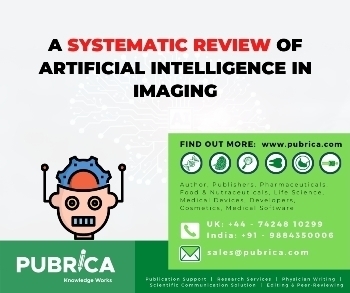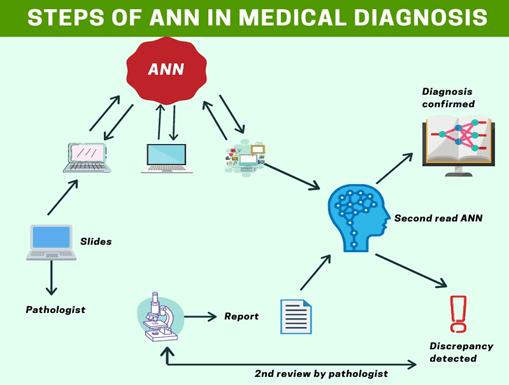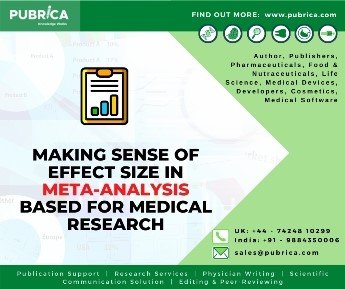
A systematic review of artificial intelligence in imaging
October 19, 2020
Case Studies in medical education: a platform for training medical students, scientific writing and critical thinking
October 26, 2020In-Brief
- An extensive source of information is available to all the medical professionals starting from symptoms to biochemical analysis using imaging devices. The artificial neural network is an AI-based medical diagnostic tool used to evaluate the vast amount of data says medical Manuscript Peer Reviewing Services.
- The process of performing an artificial neural network for medical analysis must be appropriate and relevant.
- Pubrica briefly explains the abilities, procedure, limitations of artificial neural networks in medical diagnosis.
Introduction
The process of artificial neural network analysis rises from the clinical situations that give a brief overview of the purposes of medical diagnosis with enormous confidence. Pre peer review for the neural network observes the patient’s data to detect a specific disease. Once after finding the target, the next step is to proceed the experiment with laboratory and instrumentation processes that give information about the patient’s health conditions. There are many ways to perform these processes. Many tools are there to perform the tasks. However, careful selection of tools is essential to avoid noise-based instruments in the first stage. The next stage is to formulate a database and to validate it. Likewise, there few significant steps involved in performing artificial neural network analysis, and this blog explains the steps in the artificial neural network using peer review service.
Steps involved in an artificial neural network
- Features selection
- Building the database
- Data cleaning and preprocessing
- Data homoscedasticity
- Training and verification of database using artificial neural network
- Network type architecture
- Training algorithm
- Verification
- Robustness of artificial neural network-based approaches
- Testing in medical practice
Features selection
Diagnosis ofany specific disease depends on various data. Medical professionals will extract the relevant data from each type of information to detect the most comfortable diagnosis. For artificial neural network analysis, a collection of data is known as ‘Features’ that can be symptoms, phytochemical analysis, or any other relevant information helps for diagnostic purposes. So it is closely related to the final diagnosis. The significance of Artificial neural networkis to grasp from previous samples, makes them very flexible and potential tools to perform medical diagnosis. Few types of the artificial neural networkare acceptable for solving problems while other data modelling process are more efficient in approximation. Robust indicators should help train neural networks using the clinical situation or pathology. Feature selections depend on the previous clinical case. There are a few limitations for features before the selection processes given by peer review report.
Limitations
- Insufficient
- Non-specific
- Noisy information about the problem
- Redundant
The selection of appropriate features is essential for medical diagnosis using different medical approaches with the help of medical peer review services.
Tools used
- Mathematical means of data
- Genetic algorithm
- Principal component analysis
Building the database
The “example” cases are a unified database for the neural network is training. An “example” provides patient values for the selection, collection and evaluation. The training quality and resultant generalization, the prediction capability of the network, firmly based on the training database. The database must have enough number of relevant “examples” and allow the system to learn extracting the structure hidden in the dataset. Also, clinical laboratory data must be in a document that is rapidly transferable to programs in computer-aided diagnosis using peer-reviewed articles.
- Data cleaning and preprocessing
Preprocess the training database before the evaluation process by the neural network. Scale the data between the interval for the logistic purpose. Besides, the demonstration of a few cases, some data are missing and remove it from the database set to improve the performance of the neural network. There occurs a decrease in the performance of the system for imbalanced databases.
- Data homoscedasticity
Evaluation of a training network for new patients by
- The suitable features
- Database
- Data preprocessing method
- Training algorithm
- Network architecture
- Data concerning
Homoscedasticity may lead to failure and misclassify the original data. To overcome this problem, us additional parameters that belong to a particular sample indicating the population.

Training and verification of database using artificial neural network
- Network type and architecture
There are many other network models such as Bayesian, recurrent, or fuzzy, stochastic but multilayer feed-forward neural networks are most common. The optimal network architecture selection is the first stage. The testing networks using a various number of hidden layers and nodes use them. It gives the optimal architecture for which the minimum value of E for both training and verification.
- Training algorithm
Different types of training algorithms are available.”Network learning” section, use of two training parameters:
- learning rate
- momentum.
- Verification
Verification of dataset from various data for training for the artificial neural networks-based medical diagnosis is there in the process.
- Robustness of artificial neural network-based approaches
The artificial neural network can tolerate a level of noise in the data. Consequently, they give sufficient prediction accuracy. This noise may sometimes cause false results, mainly when modelling a complicated system like the health condition of a human body.One of the best ways to avoid this is to perform the process by an experienced clinician knowing the discriminative power of the artificial neural network systems having a peer-reviewed publication.
Testing in medical practice
The final step in the artificial neural network-aided diagnosis is testing medical practice. Examination of New patient, the network’s outcome must be careful. Medical data of patients must be correct when including it in the training database. The comprehensive and extensive evaluation of ANN diagnosis applications in the clinical sector is necessary for different institutions. Only verified ANN medical diagnosis applications in the clinical industry are an essential condition for future expansion in medicine.
Conclusion
The ANN is a powerful tool for physicians to perform diagnosis. It has several advantages, like processing a large amount of data and providing relevant information. They make the diagnosis process more accessible and more straightforward. Pubrica guides you to make use of the technologies wisely in this fast-emerging world.
References
- Abdulaziz Mohsen, A., Alsurori, M., Aldobai, B., & Mohsen, G. A. (2019). A new approach to medical diagnosis using artificial neural network and decision tree algorithm: application to dental diseases. International Journal of Information Engineering and Electronic Business, 10(4), 52.
- Amato, F., López, A., Peña-Méndez, E. M., Vaňhara, P., Hampl, A., & Havel, J. (2013). Artificial neural networks in medical diagnosis.



